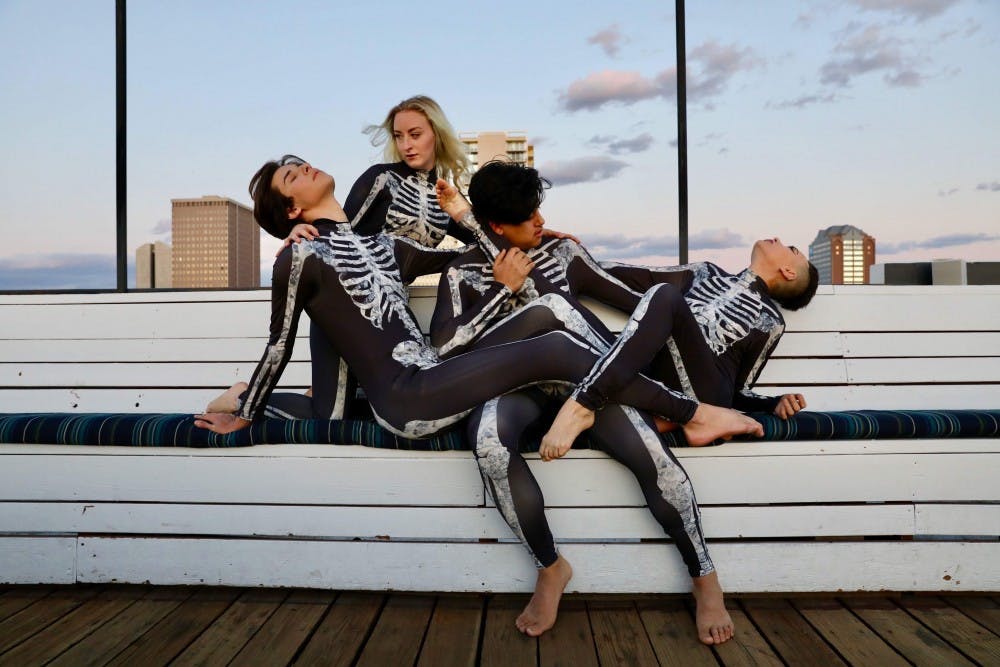In the field of psychology, homeostasis is a term used to denote the presence of stability between a person’s mental and physical state. In Japanese culture, honne and tatemae is a concept used to mark the divide between a person’s true feelings and the behavior they adopt in adhering to social convention.
For Chasity Flores and Briana Bryant, seniors in ASU’s dance program, the contrast between these two conflicting mechanisms is not only representative of the ideological push-and-pull that continues to envelop the world around them, it is an omnipresent dichotomy rife with artistic opportunity.
On April 14, the soon-to-be graduated collaborators will present these ideas in motion through "Sept," a performance art exhibition they will co-host at the Tempe Event Center.
The show, which takes its title from the French word for seven, is a sprawling performative experience consisting of two works individually authored by the creative contingents. A self-described “collaborative double feature,” "Sept" is the duo’s attempt to navigate the turmoil of social mechanisms.
And in setting out to address “humanity, social constructs, and patterns within life,” as stated on the show’s event page, the artists have drawn upon their own experiences — both joyous and trying — to illustrate their different ideas.
For Bryant, who will be debuting her work, "Homeostasis," "Sept" is an opportunity to celebrate and explore the challenges she's faced.
“I am a dance major and a psychology minor. I was finding that the term homeostasis was coming up in all of those contexts,” Bryant said. “I was really connecting with it because my piece is inspired by an accident that I went through when I was 16 years old. I was hit by a truck, basically.”
What followed was a trying road to recovery.
“I faced death, and I’m very lucky to be alive and be dancing. That’s a lot of what inspired my work,” Bryant said. “In that time of recovery, I was really amazed with how my body was able to recover and get back to dancing. That’s what drew me to the idea of homeostasis.”
Today, Bryant uses the memory of the experience to vivify her appreciation for life, and all the things she is once again able to do. With "Sept," she hopes to bring the audience closer together by way of the deeply woven personal dialogue prevalent in her work.
Flores, who will be presenting "Honne and Tatamae," approached her piece for the project from a much broader perspective. Her work, though different from Bryant’s in that it was crafted with a socially-oriented dialogue in mind, nonetheless discusses similar concepts, she said.
“I think a lot of times, we like to look at things on a spectrum and say it’s black and white,” Flores said. “But there’s always a gray area. It’s really trying to understand the complexity of that gray area in terms of the things that are socially constructed such as race and gender.”
Flores also drew inspiration from her cultural heritage.
“We as humans look at our experiences but we don’t like to look at someone else’s,” Flores said. “I think a lot of the time when people come to America, they expect people to speak English, and that’s always been a really interesting concept for me, being latina and Mexican-American. I thought it’d be really cool to use my art as a way to say that.”
Mirroring the unconventionally complementary nature of the two artists’ work, Flores also cited David Lynch, Salvador Dali and Marilyn Manson as creative catalysts in the making of "Honne and Tatamae."
Brandon Trieu, a 2016 alumnus from the ASU dance program and cast member for Flores’ "Honne and Tatemae," has been handling social media outreach and marketing for "Sept." For him, the show’s approach to the issues it aspires to tackle are both intimately and broadly resonant.
“I am a queer individual, so social constructs and the masks that you put on for society are very close to my personal narrative as a performer,” Trieu said. “I really enjoyed hearing (Flores) talk about what she wants to create. (Bryant)’s is a really strong topic about rebirth and moving past traumatic incidents. The two pieces are very different in nature aesthetically, physically and conceptually, but they connect really well together because they are so different.”
Reach the reporter at sleal2@asu.edu or follow @journaslam on Twitter.
Like The State Press on Facebook and follow @statepress on Twitter.




